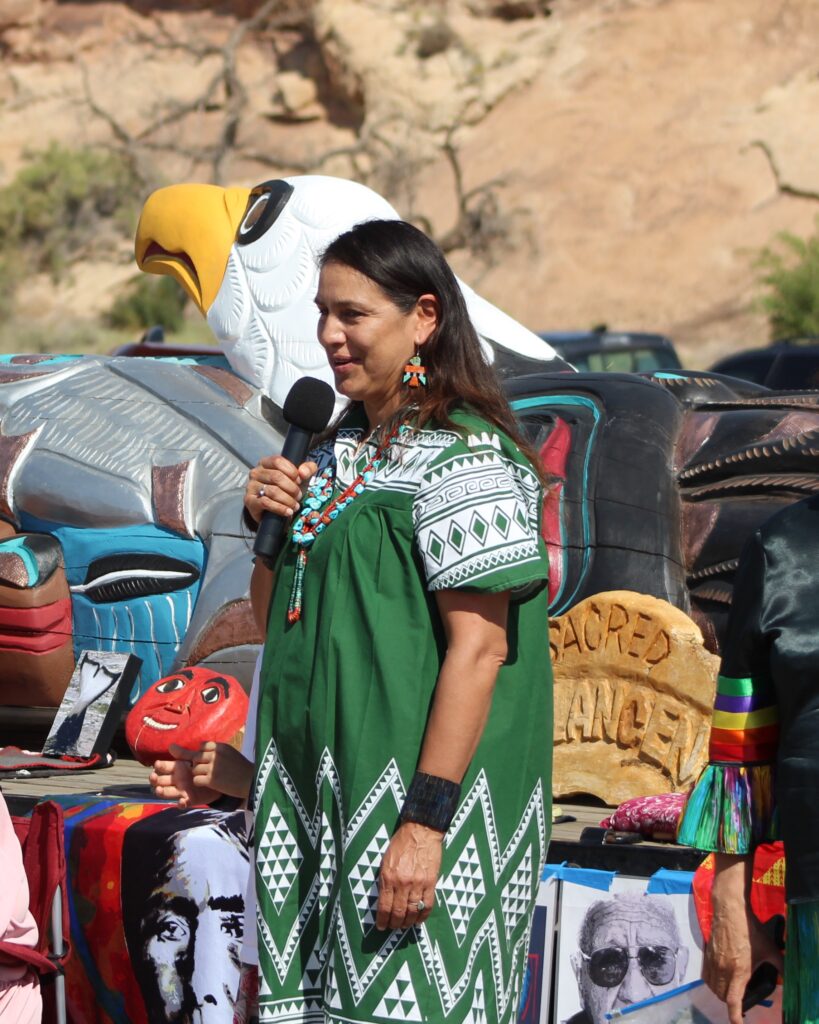Healing Journeys: Dr. Doreen Bird on Reconnecting to Ancestral Places
Ashleigh Thompson, Director of Tribal Collaboration at Archaeology Southwest, interviewed Dr. Doreen Bird (Kewa Pueblo) about the importance of protecting cultural landscapes.
Bio: Doreen Bird, PhD, MPH is from Kewa Pueblo, New Mexico. She has worked for the protection of sacred places such as Chaco Canyon in New Mexico, Bears Ears Monument in Utah, Mauna Kea in Hawaii, and has contributed to the No Dakota Access Pipeline (NoDAPL) movement to protect the water in Standing Rock, North Dakota. She is a mother of six children and grandmother of four. Her work in protecting her culture and language is never ending. She passes on the teachings she received from her parents, grandparents, and ancestors by living her life deeply connected to Creator, by being spiritually grounded and continually learning from her engagement with the Land, Water, Nature, culture and language. Dr. Bird currently works as a consultant in New Mexico and has expertise in the areas of research, public health, environmental justice, and respectful cultural engagement. Her favorite hobby is spending time with family in their garden where they are working on helping to revitalize the Bears Ears Potato, which is an ancestral food source for Pueblo People. She is developing a family business called Bird N Co, with her mother, children & grandchildren, which brings forth their ancestral gifts of creating turquoise & shell jewelry, traditional Pueblo pottery, and connecting to the arts through film and fashion.
How were you taught to interact with places like Chaco and other cultural or ancestral sites?
It is all sacred to us, all the land, and the dirt. It’s a different kind of framing of what people might think of—how to interact with ancestral places—because it’s all ancestral to us. It’s a way of conducting yourself to be spiritually connected. Everything has a soul, has a life, so we are taught to be very respectful and to tread lightly. We’re also taught not to pick up things or bother things that were left by our ancestors. That applies to Chaco Canyon or Bears Ears or Mesa Verde. We see things, even in our backyards, pottery sherds, things like that that we just know to leave alone. We don’t pick them up and take them home. It has a lot to do with respect.
How does looting and vandalism of archaeological sites impact your community, family, or yourself as a Pueblo woman?
A lot of times, we see gunshots in the petroglyphs. We’ve seen erasure happening, where whole panels are being removed.
I had an experience where a friend of mine was taking me to see a certain petroglyph. When we got there, she freaked out because it was gone. It was horrible to see her reaction to it. It’s something I hadn’t seen before, but she had been there many times and was excited to show me. That was really horrible to experience, watching a close friend of mine, seeing that horror on her face, the grief, the anger. You couldn’t believe that something like that would disappear. I started looking at the rocks along the path and could see drill marks.
People are taking out whole sections of petroglyphs. To me, that was total erasure. In a way, it’s also racism. There’s so many settlers that have encroached upon our ancestral land and in legal terms, they own it, so now, people like me have become visitors to our own ancestral land. It really hurts.
Can you talk about connecting or reconnecting to place?
I’ve reconnected with the land in the Bears Ears region. Those are places that our ancestors lived, but we migrated from that area. Other people—the Ute people, the Diné people—are the ones who live there now. But that doesn’t mean they’re the only ones who should be engaged in these conversations. If you look back further, that’s when you realize there were Ancestral Puebloans there. For example, the Bears Ears potatoes is something I’ve reconnected with. They were found perfectly preserved in the pottery, found 10,000 years [old]. That’s something that means a lot to me, when I was able to taste the potatoes.
Is there anything else you would like to share?
I think about the history of colonization. People have talked about it as historical trauma. It’s ongoing. It hasn’t stopped, so maintaining these connections for our people also helps with healing. It also helps with increasing our quality of life. It adds so much to be able to experience that in a respectful, spiritual, and loving way. It is a part of our healing, to be able to live a good life, which could add to a lot of people’s healing journeys. Those are what we seek out as families. We want to have beautiful moments like this.

